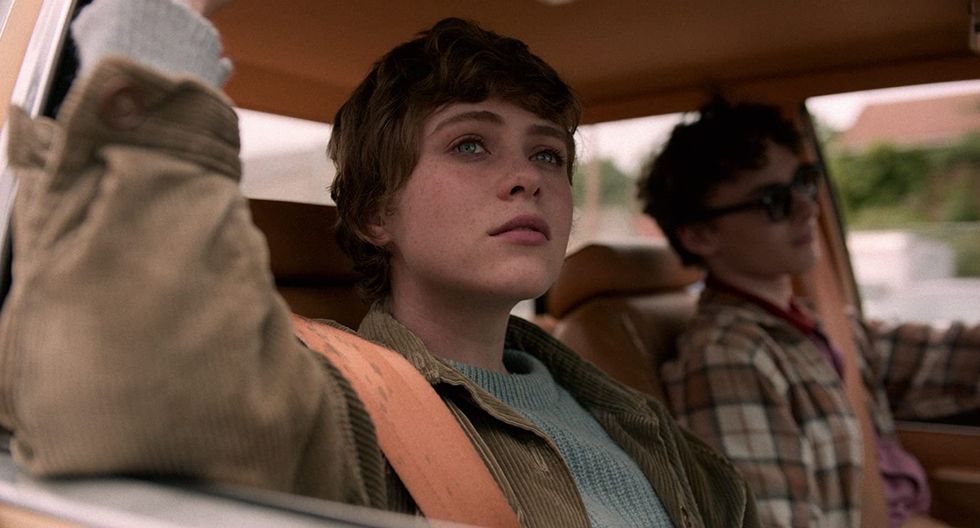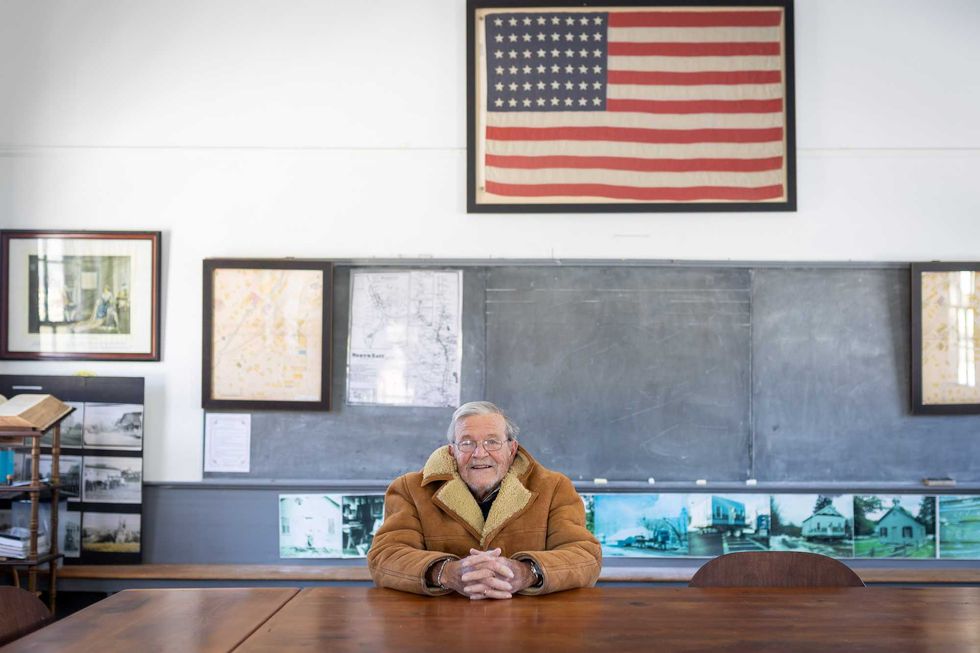A Little Horror To Brighten Up Your COVID-19 Crisis

Sophia Lillis stars in the Netflix series “I Am Not Okay with This.” Photo courtesy of Netflix

Let’s face it, this is a terrifying time: We are living in quarantine and trying to avoid infection from a potentially fatal disease.
Counter-intuitively, this might be the perfect time to check out two horror offerings from Netflix.
Some psychologists believe that watching horror can soothe viewers. There are many theories as to why, but one seems to be that watching terrifying events onscreen assures us that we’re not alone, and helps us to externalize our inner fears.
‘You’ brings horror and love
“You,” a series now being offered exclusively on Netflix is … well, it’s a romantic tale about a serial killer.
Actor Penn Badgley plays Joe Goldberg, who finds a new woman to obsess over each season and woe to anyone who gets in they way of his romantic pursuits. Think of it as “Dexter” meets “The Philadelphia Story.”
Joe is a New York bookstore owner who we come to sympathize with thanks to flashbacks to his childhood traumas and his own interior monologues. It also helps that his victims are pretty loathsome.
And, frankly, his unconditional commitment to the objects of his affection is endearing.
As you might expect, these are not traditional love stories — although critics of the show have said Joe is a traditionally manipulative narcissist and that the series is just a Bluebeard tale of cruelty and misogyny updated for the 21st century.
I think it’s better than that, with layers of complexity added in alongside references to film classics (notably “The Philadelphia Story” — a clip from the film is even added in to one episode in season two).
So where’s the horror? Well, try this. In season two, Joe is on the run from a revenge-seeking ex-girlfriend named Candace. He takes on a new identity that leads him to L.A., where he kidnaps a man named Will Bettelheim and assumes his identity. (Implausibly, Will is kept alive in a glass cage in a storage unit.)
Trouble is, the real Will owes some bad men a lot of money.Complications ensue. Joe does good things (such as defending his neighbor’s increasingly imperiled young sister). He falls in love with a chef/heiress named Love Quinn (played with star-making intensity by Victoria Pedretti from “The Haunting of Hill House”). There is a pinky-chopping Mafioso. The gore factor rises, with appendages being taken hostage and body parts being fed through a meat grinder.
Strong, grounded performances make season two’s increasingly outrageous plot twists credible.
‘I Am Not Okay with This’
Elsewhere on Netflix, 17-year-old Syd Novak is suffering from the usual adolescent woes: acne, unrequited love, crazy hormones.
One thing that sets her apart from her high school peers: She is learning to destroy and kill with her mind.
“I Am Not Okay with This” is a “Carrie”-like drama released in late February on Netflix. It is based on a 2018 graphic novel by Charles Forsman (who was the creator of “The End of the F***ing World,” which was also made into a television series).
Syd (played by Sophia Lillis) is a self-described “boring, 17-year-old white girl” who is in love with her best friend, Dina (Sofia Bryant). Unfortunately, Dina is dating golden boy Bradley Lewis (Richard Ellis). Eccentric neighbor Stanley Barber (Wyatt Oleff) is enlisted both as a heterosexual foil to match Dina’s dating and later as a hapless but charming mentor to Syd and the budding superpowers she has to learn to control.
Syd’s telekinesis is connected with rage and desire. There is also a mysterious presence that follows Syd, and that fades into black mist when anyone tries to look at it.
The producers of the Netflix hit “Stranger Things” were on board in the creation of this series, which will interest comic book fans with its superhero origin story; and which will appeal to film fans through rich cinematic moments that borrow from teen classics such as “Pretty in Pink,” “Heathers,” “The Breakfast Club” and, of course, “Carrie.”
The narrative is compelling; the characters are well-developed and are played with strength, energy and commitment by the show’s young actors. The series also serves as a mini-reunion between Lillis and Oleff, who appeared in the horror films “It” and “It Chapter Two.”
Mind-bending scenes aside, the show is also about friendship and surviving bad times. In seven episodes that approach a half-hour each, one can easily watch the “I Am Not Okay with This” in one sitting. It offers a brief but fruitful escape from the horrors of our outside world.
NF Ambery is an award-winning newspaper and magazine reporter published in Genre, The New London Day, The Register Citizen, The Hartford Courant and New York Family (where he was an editor).
Ralph Fedele sits at a desk in the historic Irondale Schoolhouse, which he led the effort to relocate to downtown Millerton.
MILLERTON — After serving for 12 years on the North East Town Board, Ralph Fedele says he has only one regret.
“I wish I could be called a ‘local,’” he joked with a warm, booming laugh.
Fedele moved to Millerton from New York City 37 years ago, in 1988, and has since worn many hats — volunteer, historian, advocate, elected official — yet he still doesn’t believe he’s earned that title.
“I’m a transplant,” he said matter of factly. “I’m from the city.”
Before settling in Millerton, Fedele spent 25 years working in merchandising at JCPenney.
His roots, however, trace back to Rhinebeck, where he grew up on a 97-acre farm and enjoyed what he describes as an idyllic childhood.
“It was marvelous,” he said, with a twinkle of nostalgia in his eyes. As a boy, he climbed apple trees, spent hours in the family barn’s hayloft, played with neighbors until sunset, and helped his Sicilian grandmother — his nonna — in the garden. Today, Fedele wears her ring. “Any time I’m a little depressed or I want to remember,” he said, “I can talk to her.”
Growing up with an Italian grandmother sparked a lifelong love of history and culture. That curiosity eventually took Fedele to Italy, where he visited the church in which his grandmother was baptized. “Because I love history so much, I wanted to know where my grandmother was from, so I traveled to her village in Sicily.”
Along the way, he uncovered another piece of family history. His great-grandfather, Giovanni Nicolini, was a noted Italian sculptor whose work still stands outside Palermo’s Teatro Massimo, the largest opera house in Italy. Fedele later made a pilgrimage there and photographed his ancestor’s name on the bronze plaque outside of the theater.

The Irondale Schoolhouse
Years after settling in Millerton full time, Fedele was driving north on Route 22 when he spotted an old, classic building and couldn’t stop thinking about it.
“It was in dire straits,” he recalled. “Right on the road, but beautiful. I remember thinking, ‘Wouldn’t that be a great building to move into the village?’”
That moment would eventually turn into Fedele’s lasting legacy.
He left his post at the North East Historical Society to found Friends of the Irondale Schoolhouse, leading an eight-year effort to “move, restore, and repurpose the building.”
Supervisor Chris Kennan said the project remains inseparable from Fedele’s name. “Every time I pass by the Schoolhouse, I think of Ralph,” Kennan said. “It was his vision and persistence that enabled this dream to become a reality.”
Fedele joked that people may have thought he was crazy during the lengthy restoration. “I was a tyrant,” he said with a laugh. “I really made sure that we were able to get it done.” The effort required coordination with the state, the county, village and town officials, and his newly assembled nonprofit board.
As a self-proclaimed history buff, Fedele didn’t stop at the restoration. He found a list of students in old records and did what any determined historian would do. He opened the telephone book and started making calls.
Eventually, he tracked down one of the schoolhouse’s original students — Mary (Mechare) Leitch — who, at the age of 101, returned to the building after renovations were complete.
“It was a marvelous time,” smiled Fedele. “I was so happy to see her.”
‘Trust is earned’
Today, even though he won’t call himself a local, Fedele is a familiar fixture in town. You can find him each week enjoying conversation and a cup of coffee at Talk of the Town Deli, or getting stopped in town by neighbors and friends for a chat.
“I have gained the trust and confidence of a lot of people,” Fedele said. “It comes a little bit at a time. Trust is earned.”
Not only has Fedele served as a town board member, he has volunteered for Townscape and served as the president of the North East Historical Society. He was also one of the first advocates of preserving history by fixing toppled gravestones at the Spencer’s Corners Burying Ground.
His service was formally recognized at his final Town Board meeting through a resolution commending his three four-year terms as councilman, citing his “good humor, kindness to all and deep concern for the community’s senior citizens and for those living on fixed incomes.”
An emotional Fedele addressed the room with a mantra he often repeats. “When you leave, leave this place a little bit better than you found it,” he said. “That’s what I have always tried to do.”
Neighbors react
During the public comment, several residents stood to thank Fedele.
Claire Goodman, a member of the village Zoning Board of Appeals and Townscape volunteer, said Fedele was among the first to welcome her to Millerton.
“Whether we’re standing out in the cold, scrubbing tombstones at Spencer’s Corners, or ringing the bell at the schoolhouse, you always have such grace and you’re such a gentleman.” She added, “The way you laugh, it opens my heart.”
Kathy Chow, who serves on the Conservation Advisory Council and the Climate Smart Task Force, referred to Fedele as a “pitbull,” adding, “We all have hard things that we do, and we keep pushing at it, but you’re the one who makes me think I can keep going.”
Fedele describes his retirement from the town board as bittersweet. “I’m going to miss this,” he said. “I really am.”
Mad Rose Gallery on Route 44 in the Village of Millerton is decked out with lights and decorations to celebrate the holiday season.
MILLERTON — The Village of Millerton is inviting residents and businesses to enter its annual house decorating contest, with judging now underway through Dec. 28.
Awards will be presented in several categories, including Best Lights, Most Creative, Best Overall and Best Commercial Front.
Entries will be evaluated by a panel of judges using established criteria. Creativity will be judged based on originality, variety of materials used and the use of homemade vs. commercially made decorations. Appearance will consider color coordination, balance and overall attractiveness, while effort will reflect the time and energy put into preparation and presentation.
Judging will be conducted by drive-by observation between 6 p.m. and 11 p.m., and displays must be clearly visible from the street side of the house at night. People and pets may not be included as part of the design.
Winners in each category will receive a gift basket, gift certificates and recognition in The Millerton News. Awards will be distributed on Friday, Jan. 9, 2026.
The contest is open to residents and businesses in the Village of Millerton and the Town of North East. Entry forms can be obtained from Village Hall or at villageofmillerton-ny.gov.